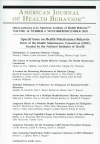
Food Melt in Consumer Food Environments in Low-income Urban Neighborhoods
Keywords: ACCESS; FOOD ENVIRONMENT; FOOD STORES; LOW-INCOME; SNAP; URBAN
Document Type: Research Article
Affiliations: 1: Assistant Professor, Prevention Research Center for Healthy Neighborhoods, Case Western Reserve University, Cleveland, Ohio;, Email: [email protected] 2: Research Associate, Prevention Research Center for Healthy Neighborhoods, Case Western Reserve University, Cleveland, Ohio 3: Professor, Prevention Research Center for Healthy Neighborhoods, Case Western Reserve University, Cleveland, Ohio 4: Associate Professor, Prevention Research Center for Healthy Neighborhoods, Case Western Reserve University, Cleveland, Ohio 5: Assistant Professor, Cleveland State University, Cleveland, Ohio 6: Department of Sociology, Case Western Reserve University, Cleveland, Ohio 7: Institute for Social Research, University of Michigan, Ann Arbor, Michigan
Publication date: 01 November 2017
The American Journal of Health Behavior seeks to improve the quality of life through multidisciplinary health efforts in fostering a better understanding of the multidimensional nature of both individuals and social systems as they relate to health behaviors.
The Journal aims to provide a comprehensive understanding of the impact of personal attributes, personality characteristics, behavior patterns, social structure, and processes on health maintenance, health restoration, and health improvement; to disseminate knowledge of holistic, multidisciplinary approaches to designing and implementing effective health programs; and to showcase health behavior analysis skills that have been proven to affect health improvement and recovery.
- Editorial Board
- Information for Authors
- Submit a Paper
- Subscribe to this Title
- Review Board
- Reprints and Permissions
- Ingenta Connect is not responsible for the content or availability of external websites
- Access Key
- Free content
- Partial Free content
- New content
- Open access content
- Partial Open access content
- Subscribed content
- Partial Subscribed content
- Free trial content